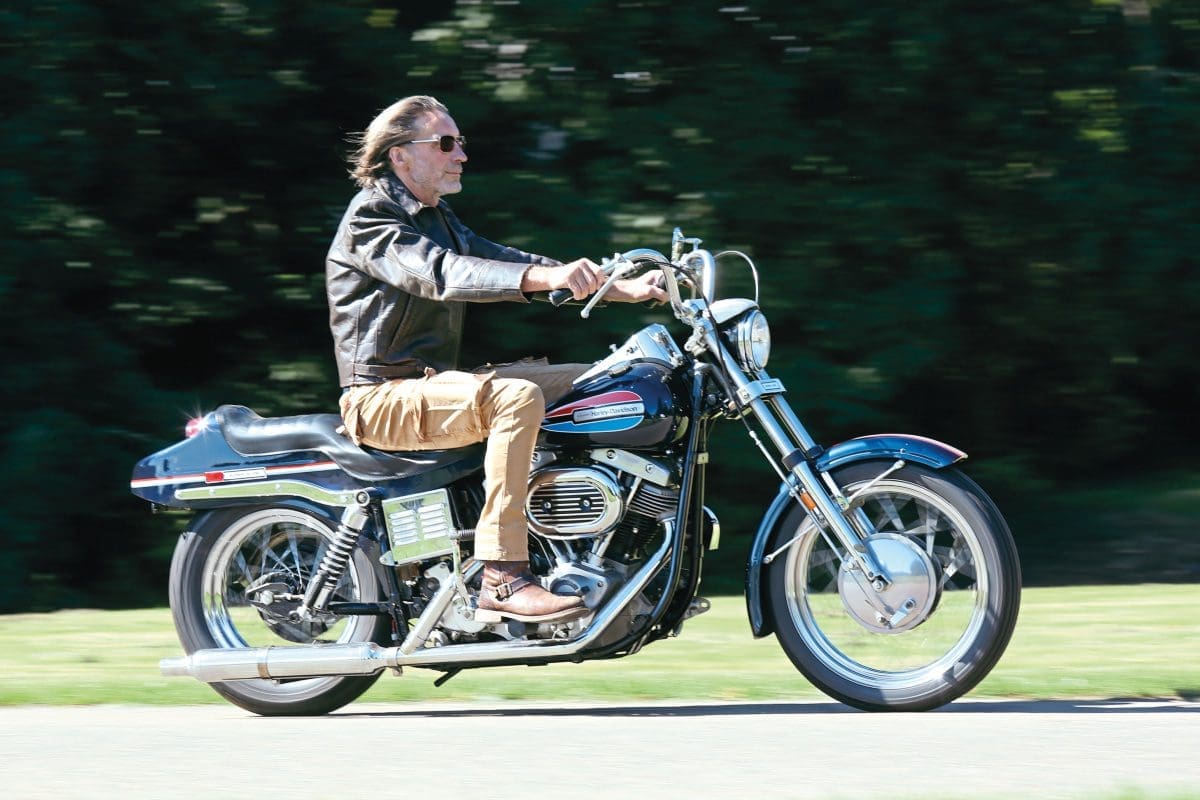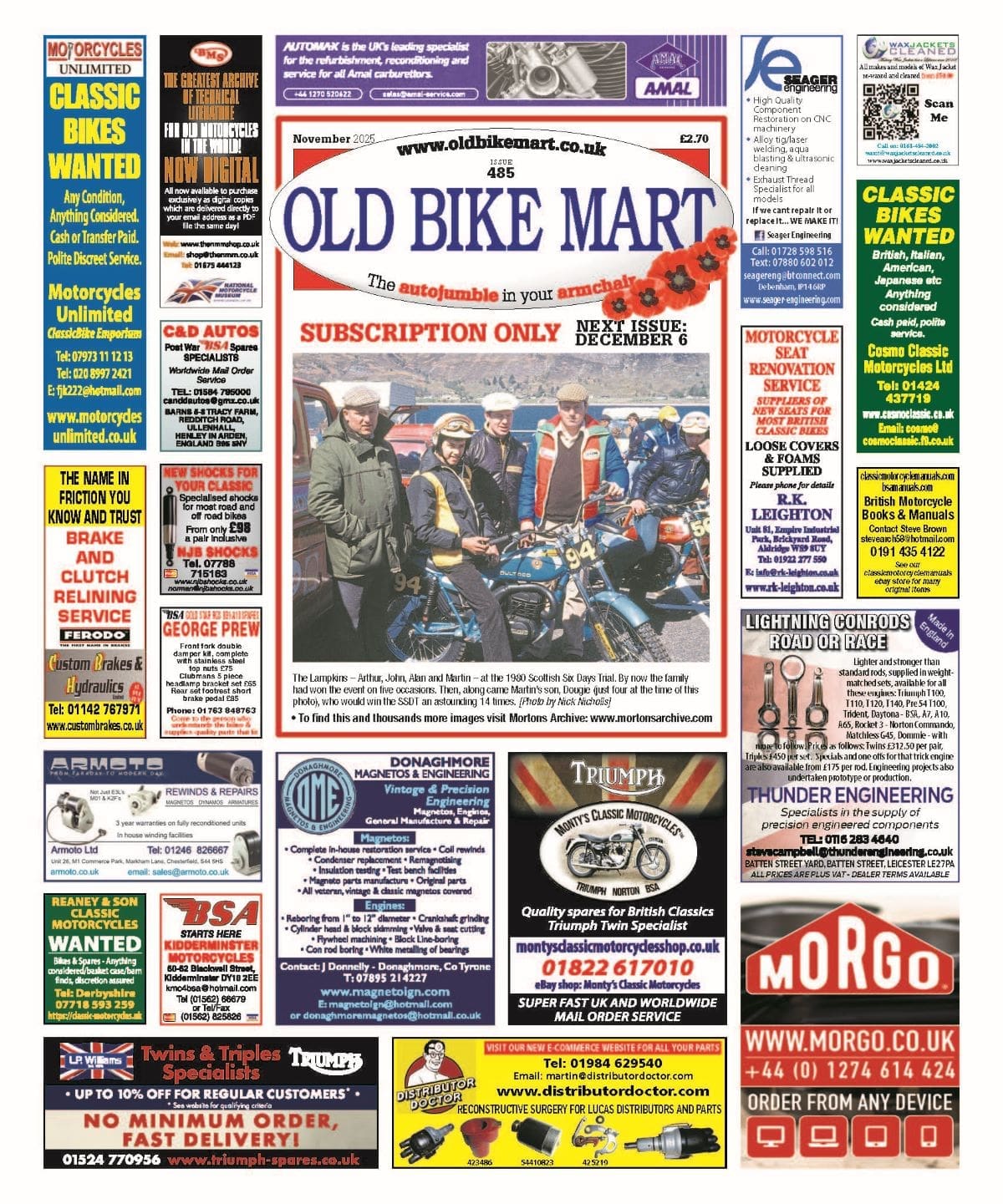
Image: Onno “Berserk” Wieringa – madnessphotography.nl
The Super Glide, which saw the light of day as the FX in 1971, was the first design of the acclaimed Willie G. The type designation FX was a combination of the F designation of the Electra Glide FLH and the X of the Sportster line, such as the XL and the XLH; the Super Glide finally used the front end (the forks and 19in wheel) of the Sportster, and much more parts (frame, engine, transmission etc.) of the Electra Glide. It was H-D’s first factory custom to become the ancestor of many custom and chopper versions.
The Boat tail rear fender was standard on the models in 1971, but already after one year it was replaced by a ‘normal’ fender. In 1973 the Super Glide got the characteristic petrol tank, derived from the Aermacchi Sprint models. With the addition of the electric starter (with which the FX got the letter E; FXE ‘Electric’ starter) came, first as an option, in 1974. So the Super Glide is a motorcycle with history.
Enjoy more classic motorcycle reading, Click here to subscribe to one of our leading magazines.
History of the first factory custom
In the late 1970s through to the early 1980s, Harley-Davidson inventively responded to the increasingly popular chopper craze. Ready-made custom bikes had not been available until then.
Along with models like the Fat Bob, the Low Rider, the FXWG Wide Glide, and the Sturgis that all shared the same frame and engine, the FX Super Glide is one of the first true factory customs to be produced in Milwaukee.
Willie G’s first design, the ‘71 Super Glide, sparked off a lot at the time. Willie G. Davidson is a descendant of one of the founders of Harley-Davidson; his grandfather was William A. Davidson.
Willie G became Vice President of Styling at H-D in 1978, and the man turned out to have a talent and a vision to lead H-D with his custom creations to beat the competition, and was often ahead of his time.
After the Second World War the soldiers returned home. Back in the USA, it turned out that the common people did not understand them, so the men often visited each other and found the camaraderie they so missed in being together. There was not much money, and the restless groups travelled through the country on cheap, discarded army motorcycles. Clubs emerged that often bore the name of former squadrons.
To make the motorcycles faster, a few things were disassembled and sawn off, the so-called Bob-Jobs, and after the Bobber the Chopper was created, to make the motorcycles more stable, the front forks were slightly lengthened, which soon resulted in a fashion phenomenon where forks became so long that they were hardly rideable.
The movie The Wild One, with Marlon Brando as one of the protagonists, left a mark on the bike scene. Motorcyclists were seen as scum and the term outlaw was soon used.
The AMA (American Motorcycle Association), the overseeing motorcycle association, fearful of its reputation, soon proclaimed that just one per cent of motorcyclists were ‘outlaw scum’ – a statement that the group in question saw as a kind of tribute… the ‘1%’ logo has been proudly worn by members of MCs ever since!
In 1969, after the release of the movie Easy Rider, in which Peter Fonda, Jack Nicholson and Dennis Hopper on two real choppers played the main roles, the chopper look was adopted worldwide by enthusiasts of these strikingly-styled bikes.
At Harley-Davidson, the trend did not go unnoticed. Willie G was often far ahead of his time and saw early on what was to come. According to unconfirmed but very persistent rumours, the story goes that someone pushed an Electra Glide without a front fork on a cart through the factory, and someone else just came around the corner with a complete front fork of the sportive Sportster. The two almost collided and Willie G, who witnessed the event, immediately ‘saw’ his next design in front of him: a bare Electra Glide with the front forks of a Sportster on it – a Superbike, as was already supplied by the competitors (both English and Japanese) back then, and which H-D needed to provide an answer to. It became the Super Glide that saw the light of day in 1971. The then optional rear of the Sportster with the long plastic rear fender was also fitted to the first Super Glide by Willie G, and the nickname Boattail became fact. This bike was Harley-Davidon’s first true factory custom.
The Super Glide, based on the drivetrain and frame of the FLH and the front fork, brakes and headlight of the Sportster XLH, was given the type designation FX – one of the very few type designations that actually makes sense, especially for outsiders, for something in the completely incomprehensible list of type designations: FX stands for Factory Experimental (Xperimental – get it?). In addition, FX stands for the combination of the two models, F for the FLH chassis and X for the XLH, of which the front fork was used. However, the Super Glide was hardly appreciated, especially the boattail rear fender that many thought was horrible, which was also the case with the Sportsters.
Why did Harley choose the plastic mudguard at that time? The reason was that AMF (American Machine and Foundry), which included Harley-Davidson at the time, was also a manufacturer of golf carts. These were made of plastic. To speed up production and have more influence on the production process, AMF bought a plastics factory that could manufacture both bodies for golf carts and parts for H-D, including the illustrious Boattail.
It was first optionally used for the Sportster models. Only a few of them still exist, and the models with the special Turtle tank are almost never seen and worth their weight in gold. A short time later, in 1971, the long fender was also added to the Super Glide.
The Super Glide was aptly nicknamed Boattail immediately after its introduction, but few know that the first official name given by H-D to the model was Night Train. It was scrapped after a short time for unknown reasons and would become the designation for a line of Softail models many years later.
Features of the Boattail, which are now the hard-to-find parts, include the well-known plastic saddle-fender unit with the round rear light, the exhaust system, the No.1 logo on the tank strip, the Super Glide logo on the headlight, the thin 35mm fork legs with accompanying drum brake, the primary outer box with the mounting bracket for the footboard as it was originally on the FLH, and the logos and stripes.
The rear wheel with drum brake on the Super Glide also used the round swingarm as in the older Early Shovelhead frames. Instead of the running boards like on the FLH, there were now footrests on the Super Glide. The shift pedal was reversed on the shift shaft, causing it to return to the footrest. The rear brake control also had to be adapted for footrests. H-D used the two-piece Fat Bob tanks, and the horn came from the XLH and was mounted on the front left frame tube. This FX was originally kick-only, which sometimes caused starting problems due to the Bendix carburettor. At the front was a 19-inch wheel, and a 16-inch at the rear.
A glorious example
Bennie, who owns Twin Performance in Ommen in the Netherlands, is, together with his wife Ella, a great lover of classic Harleys. He bought the bike from an acquaintance in Belgium. The boattail is not 100% original, as we see when we check the bike a little closer. The crankcases, although not conspicuous, have been replaced at some point by Harley-Davidson under warranty, therefore keeping the original number. That was then stamped on the left by H-D instead of the front right. It is suspected it was done just after the introduction of the electric starter on these models in 1974, and that the owner had the ‘electric leg’ fitted on it for the sake of convenience.
The battery cover and some wearing parts such as the battery, tyres and the like are logically no longer original – but the rest is gloriously so.

Image: Onno “Berserk” Wieringa – madnessphotography.nl
Super stands for Superbike and the Glide add-on comes from the existing big 1200cc bikes from that time, the Electra Glides. It is especially these models, the Super Glides, which had an enormous influence on the market at the time and is still noticeable even today – the models from the 1970s and early 1980s are icons in the world of custom bikes. Introduced at the end of 1970, this FX series produced 4700 in the only year it came with the boattail as standard, in 1971, with a choice between Birch White and the much rarer Sparkling Blue.
The Super Glide was in the programme until very recently, just like the Wide Glide, which was even the first ultimate custom bike to be delivered with the famous flamed custom paint set in 1980. It was a time when not many people rode motorcycles, and when the real die-hards – bikers for whom their H-D meant everything – remained loyal to their brand and continued to believe in it. These people kept Harley-Davidson – now one of the most successful motorcycle manufacturers – afloat.
Since then, many styles and movements have been reviewed and often. Just like in fashion, certain styles return over the years. Retro and Bobber are hot at the moment, especially in Europe. The Hot Rod style and Frisco area choppers were fast and light. Bay Area Low Riders and Diggers were low with eye-catching paintwork and engravings, and some even sporting gold leaf. The Techno Chopper has had few followers, while the Swedish-style Chopper with the long, low bikes is still popular.
The High Neck Chopper hype has passed away with a group of enthusiastic followers, just like the Walz Style deepseaters, wide and fat bikes with 300mm or wider rear tires, except for a few extravagant Low Riders who often turn out to be trendsetters. The aggressive Streetfighter look continues to evolve, as does the fast, sporty styling; it is a relatively small group that adheres to the Clubstyle. Baggers and Mexican style are popular in the USA. Numerous currents and sub-currents are derived from the primeval models, the Bobber and the Chopper.


